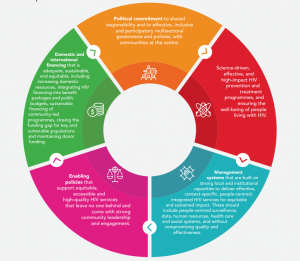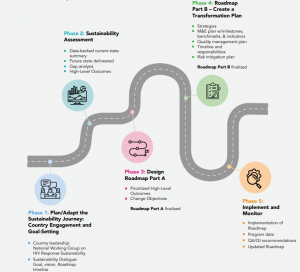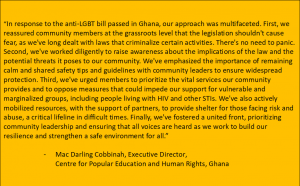
UNAIDS shows the way – HIV response sustainability primer
Author:
Amida Kariburyo
Article Type:Article Number: 7
Are you looking for a comprehensive guide on sustainability of health intervention in the context of HIV? UNAIDS shows the way through its “The HIV Response Sustainability Primer" as the deadline for ending HIV/AIDS as a public health threat by 2030 approaches. This article offers a peek into the primer, highlighting some of its key elements and the roadmaps it details to plan for sustainability beyond this timeline.
The HIV response sustainability primer of UNAIDS highlights the urgent need for countries to plan for sustainability. It proposes a forward-looking strategy to sustain the achievements of the global HIV response beyond the 2030 goal of ending AIDS as a public health threat. It emphasizes the need for a transformative approach focused on human rights and individual needs. Additionally, it stresses the importance of leveraging societal catalysts, addressing vulnerabilities, and ensuring access to services.
Countries are encouraged to develop roadmaps for the sustainability of the HIV response, using specific data to tailor strategies to their unique contexts (Figure 1). Finally, the primer emphasizes the importance of flexibility and resilience. It also highlights the need for collaboration between countries and international partners to promote the sustainability agenda.
Figure 1: Country roadmap cycle, design and implementation

Global efforts to achieve the AIDS targets set for 2025 and 2030 have led to steady but uneven progress in the fight against HIV. While new HIV infections have majorly declined worldwide, the rate of decline varies across countries. Some countries, particularly in sub-Saharan Africa, have made significant strides, while others have not seen significant change due to persistent inequalities. AIDS-related deaths have also decreased since 2010, but reducing AIDS-related mortality remains challenging.
To eliminate HIV/AIDS as a public health threat by 2030, a transformative approach to the HIV response is necessary. This includes integrating HIV services with other health services, addressing the unique needs of the ageing population living with HIV, and prioritizing sustainability. Additionally, it is crucial to reassess program activities and consider the changing demographics and health needs of people living with HIV. Despite progress in the fight against HIV, a radical change in approach is required to achieve the global targets for 2025 and 2030 (Figure 2). This involves reducing persistent inequalities, ensuring access to treatment and viral suppression, and adapting to the specific needs of populations living with HIV.
Figure 2: Estimated number of people living with HIV by age and gender, Eastern and Southern Africa, projections 2010, 2030 and 2050, assuming the 2025 global HIV targets are met.

HIV funding under threat
HIV funding is facing a major crisis, putting the long-term sustainability of AIDS efforts at risk. In 2022, funding in low- and middle-income countries fell to $20.8 billion, well below the $29.3 billion needed by 2025, bringing it back to 2013 levels. Two main factors contribute to this shortfall. First, there has been a decline in international aid (Figure 3). Despite some funding from sources like the Global Fund and PEPFAR, overall aid for the fight against HIV has decreased significantly since 2010, despite the high returns on investment. This decline is worsened by competing priorities such as climate change and concerns about aid effectiveness. Second, national funding has stagnated (Figure 4). The COVID-19 pandemic has worsened the global economic slowdown, impacting public spending in many countries, especially in areas such as health and education. Rising inflation and unsustainable debt burdens have led to reduced healthcare spending, even in regions where debt interest payments exceed investments in health and education. Resolving this crisis requires a multi-dimensional approach that emphasizes global solidarity, shared responsibility, and innovation in resource mobilization that includes improving resource allocation, ensuring countries take ownership, reducing donor fragmentation, and aligning international assistance with the principles of aid effectiveness.
Figure 3: International resources for HIV in low- and middle-income countries, 2000-2022

Figure 4: National resources available for HIV in low- and middle-income countries, 2010-2022

New Approach to Sustainability
The new sustainability framework approach (Figure 5), and components aim to bring about lasting change in the fight against HIV, ensuring control of the epidemic beyond 2030 while guaranteeing the right to health for all. It focuses on a country’s ability to use people-centered health systems, autonomous institutions, and sufficient resources in an enabling environment to end AIDS as a public health threat and promote equity. This approach, aligned with the perspectives of the Global Fund and PEPFAR, emphasizes the importance of political, programmatic, and financial sustainability of HIV programs. It will serve as the foundation for developing country-specific roadmaps for the sustainability of the HIV response, building on past efforts to strengthen sustainability.
Figure 5: Approach to the sustainability of the HIV response

The proposed sustainability framework for the HIV response highlights five key elements for achieving and maintaining global AIDS targets while ensuring equity. These elements are as follows:
1. Political commitment: The focus is on shared responsibility and inclusive governance, with active participation from communities.
2. Effective prevention and treatment programs: Priority is given to science-based interventions that prioritize the well-being of people living with HIV.
3. Strong management systems: Advocacy for strong local and institutional capacity to deliver integrated, context-sensitive, and person-centered HIV services while maintaining quality and efficiency.
4. Enabling policies: Support for equitable and accessible HIV services through strong community leadership and commitment.
5. Sustainable funding: Calls for adequate and sustainable national and international funding, including increasing domestic resources, integrating HIV funding into public budgets, and reducing funding gaps for key and vulnerable populations.
Key recommendations for new sustainability roadmaps include:
– Starting with the future in mind: Identifying the ultimate impact that the response aims to achieve and sustain to understand the necessary transformations at policy, program, and systems levels.
– Prioritizing high-level outcomes: Defining sustainable improvements in policy, programs, health systems, financing, and societal factors based on sustainability goals.
– Focusing on transformations: Bringing about significant and lasting changes to HIV programs, policies, systems, and financing to remove obstacles and inequalities.
– Tailoring transformations to context: Adapting interventions according to country-specific data and needs, integrating HIV services into primary health care without compromising access or quality.
– Using a dynamic approach: Continuously reviewing, evaluating, and adapting the roadmap to changing epidemic patterns, health systems, financing, and the enabling environment.
– Influencing donor actions: Highlighting the investments needed to transform programs and systems while advancing MDG 3 and ensuring health security.
– Implementing all elements: Ensuring the implementation of all five components of the framework to achieve and sustain disease control, as they are interdependent and mutually reinforcing.
Country Sustainability Roadmap
Towards a new generation of sustainability roadmaps, the Country Sustainability Roadmap is a customized plan at the national level to achieve global HIV targets and maintain impact beyond 2030. It emphasizes several guiding principles:
1. Alignment with national priorities.
2. Meaningful and measurable involvement of civil society, particularly people living with HIV and key vulnerable populations.
3. Emphasis on human rights, non-discrimination, and gender equality.
4. Use of the best available scientific evidence and technical knowledge.
5. Promotion of comprehensive responses to HIV, integrating prevention, treatment, care, and support.
The roadmap is structured as follows:
1. It takes into account short- and long-term objectives, flexibility, and the anticipated impact of actions on a country’s sustainability.
2. It requires strong commitment from countries to define key objectives, clarify the vision, and establish development timetables.
3. International partners offer templates and guides to support the roadmap process.
4. The roadmap is divided into phases, including a sustainability assessment of the current state of the HIV response, Roadmap Part A, Roadmap Part B, and implementation, monitoring, and adjustment.
5. The roadmap comprises four main elements: sustainability assessment, Roadmap Part A, Roadmap Part B, and implementation, monitoring, and adjustment.
The process of developing a roadmap for the sustainability of the national HIV response is divided into five phases (Figure 6):
1. Planning the sustainability journey (January-March 2024): This includes establishing inclusive processes for country engagement and target setting, forming a Sustainability Task Force, and launching sustainability dialogues to define tailored objectives and impact targets.
2. Sustainability assessment of the current state of the HIV response (April-June 2024): This phase involves conducting a rapid, focused literature review to assess the state of sustainability in the country’s HIV response, identifying gaps and challenges, and prioritizing high-level objectives and targets for change.
3. Developing Part A of the roadmap for sustainability in the country’s HIV response (July-December 2024): This phase uses assessment results to develop Part A, focusing on high-level and change objectives, and prioritizing OSS through transparent and participatory approaches.
4. Developing Roadmap Part B – Creating a transformation plan (January-May 2025): This phase entails developing a transformation plan that outlines strategies and interventions to achieve change objectives and SOAs, including monitoring and evaluation, quality management, risk mitigation, and implementation schedules.
5. Implementation and monitoring (from June 2025): This final phase involves implementing the transformation plan through detailed country plans, monitoring progress, making necessary adaptations, and engaging stakeholders for oversight and coordination.
Throughout these phases, there is an emphasis on stakeholder engagement, transparency, and adaptability to effectively guide the country’s HIV response toward sustainability.
Figure 6: Roadmap for the sustainability of the national HIV response

The new approach advocates for renewed political commitment, mobilizing resources to support the HIV response, engaging with continental and regional institutions and partners, supporting national plans for the sustainability of the HIV response, promoting innovation and capacity building, and strengthening partnerships and resource mobilization to support country efforts.
Conclusion
The UNAIDS primer on the sustainability of the HIV response lays the groundwork for transformative action beyond 2030 and has the potential to bring about significant change and preserve the progress made in the fight against HIV/AIDS for future generations. However, as key populations find themselves increasingly marginalized and with the criminalization of the LGBTQI+ community, it’s going to be an uphill task but not an impossible one with the pushback coming from not only UNAIDS and other global health institutions but the community itself to shape a strategy that ensures they retain their rights and access to health services (see below).

